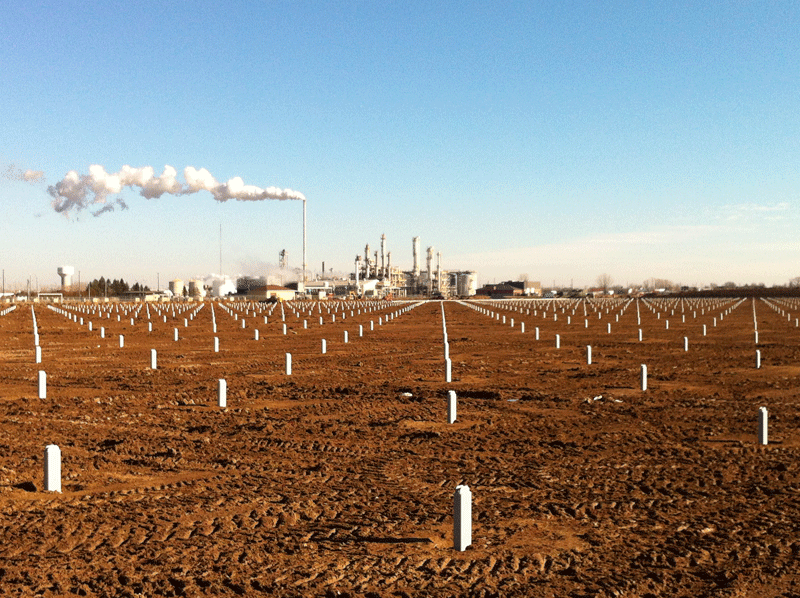Waste not, want not
A UNIQUE AGRICULTURAL PARTNERSHIP
managing resources and protecting the environment are key to the development of a new tomato greenhouse in Chatham, Ontario; so naming the new venture, ‘Truly Green’ is a natural choice.
“It’s simply a description of the farm and what it is all about,” says Greg Devries, President of Cedarline Greenhouses.
Devries comes from a grain and oilseed family farm in Dresden, Ontario where they’ve also been involved with hog and cattle operations. In 2003, they opened Cedarline Greenhouses, a 16 acre facility growing bell peppers. When Devries started to look at expanding the greenhouse business, he discovered an opportunity for a unique partnership.
PHOTO: SITE OF ‘TRULY GREEN’ ACROSS THE ROAD FROM GREENFIELD ETHANOL’S CHATHAM PLANT

“When you’re operating a vegetable greenhouse, forty percent of the cost of operation is heat,” says Devries. “And if you’re going to be competitive in the future you need to be able to mitigate some of that cost.”
recognizing the possibilities
While looking at ways to reduce his costs, Devries was reminded of his association with GreenField Ethanol in Chatham. He sells corn to them and buys back distiller’s grains. Living in the area, he also couldn’t help but notice the vapour constantly being released from the large stack towering above the facility which turns 487,000 metric tonnes of corn into 195 million litres of ethanol every year. During the process waste heat is generated.
Devries also knew that the GreenField plant would have something else he needed – a steady supply of CO2. “In the greenhouse industry we use a lot of supplemental CO2. And the time of year we need the most CO2 is in the summer time when the plants are at their most active growing stage,” Devries explains. He approached GreenField’s innovation team about how he could use their waste streams to fill his need for heat and CO2. It was a partnership they were willing to develop.
“It really fit within our vision of creating a bio-refinery complex while improving our overall greenhouse gas footprint,” says Marty Cormier, VP Bulk Manufacturing, GreenField Ethanol. “Our long term vision for this plant is to expand and diversify our product streams by building on our base ethanol process, and this opportunity is really a perfect fit for us.”
making the project work
Truly Green Farms is being built on Bloomfield Road, directly across from the ethanol facility, making it easy to pipe hot water and CO2 between them underground. The 22.5 acre greenhouse complex is expected to be completed, with tomatoes planted, by July of this year. It’s the first of four stages which could expand the greenhouse to 90 acres over the next 10 years, if the market allows for the additional supply of tomatoes.
The energy that GreenField is providing to the greenhouse is coming from two primary sources in their plant. One is the cooling water return that is used to remove heat from various process streams. “We plan to take our warm cooling water return and combine it with condensed dryer stack vapours to produce a hot water energy stream for the greenhouse. In our case, these are two energy streams that cannot be feasibly re-used in our plant, so it’s a good opportunity to extract useful energy out of those waste streams,” explains Cormier. “The interesting thing about the stack vapour is that the energy is low grade energy that cannot be re-used in the plant. By condensing the vapours, and recovering the heat that’s in them, we can produce 65 degree Celsius water and that’s ideal to heat up the greenhouse.”
GreenField will also be supplying up to five tonnes of CO2 per hour, and up to 100 tonnes of CO2 per day, depending on the demand of the greenhouse. The CO2 is generated during the ethanol production process.
Cormier explains that the starch in corn is converted through enzymes to sugars, and those sugars get fed into a fermentation process. In that fermentation process, live organisms (yeast) consume the sugars and produce ethanol and CO2 almost in equal proportions in terms of weight. “The ethanol is further distilled to produce fuel grade ethanol and industrial alcohol. The CO2 from our fermentation process is captured with the majority of the product being purified and processed on-site by Praxair. We do have excess CO2 from the fermentation process and that’s the CO2 that is being supplied to the greenhouse.”
a natural fit
The readily available CO2 is one of the reasons Devries decided to grow tomatoes at this greenhouse complex. “Every plant takes in CO2, but tomatoes are able to use it more efficiently and translate that into increased production,” he says. “I think we will be able to push the level and get a five percent increase in production over a typical greenhouse.” Up to 21 million kilograms of tomatoes are expected to be produced on an annual basis.
Corn producers may see a benefit from the partnership because it will help secure the demand for their commodity at the ethanol facility. “It helps us improve our long-term viability because we now have another source of revenue for some process streams that we otherwise wouldn’t be able to recover,” says Cormier, who notes their corn use has already increased by more than four million bushels a year since the Chatham plant opened in 1997.
But, what nearby farmers won’t see anymore is that initial sign of waste that first triggered the idea for this project. “Once this is on-line we should see a significant change in the appearance of the stack,” says Cormier, “the normal vapour that you see coming out of the stack will practically disappear. There will still be warm air coming out, but there will no longer be any vapour.”
The provincial government has recognized the environmental and economic benefits of the project with a $3.2 million dollar investment. The investment was made to support innovation in Ontario’s agri-food and agri-products industries; and it was recognized that this project is an example of how agriculture is growing Ontario’s future.
“I think there are a lot of other unique partnerships available out there to help agriculture progress and make ourselves more competitive and innovative in the future,” says Devries. •







